Abstract
Traditional building energy consumption prediction methods lack the description of occupant behaviors. The interactions between occupants and equipment have great influence on building energy consumption, which cause a large deviation between the predicted results and the actual situation. To address this problem, a two-part prediction model, consisting of a basic part related to the building area and a variable part related to stochastic occupant behaviors, is proposed in this study. The wavelet decomposition and reconstruction method is firstly used to split the energy consumption. A relationship between the low frequency energy consumption data and the building area is discovered, and an area-based index is used to fit the basic part of the prediction model. With a quantitative description of the occupant–equipment interaction by classifying the equipment into environmentally relevant and environmentally irrelevant equipment, an agent-based model is established in the variable part. According to the validation given by two case office buildings, the prediction error can be controlled to 2.8% and 10.1%, respectively, for the total and the hourly building energy consumption. Compared to the prediction method which does not consider occupant–equipment interactions, the proposed model can improve prediction accuracy by 55.8%.
1. Introduction
Buildings contribute to more than 30% of primary energy usage globally [1]. Office buildings, as the representative type of public buildings, have a greater potential for energy efficiency [2]. Accurate and effective prediction of energy consumption is an important basis for energy efficiency and design optimization in buildings [3]. However, there is a large discrepancy between the monitored energy consumption and the predicted values [4]. Deviations between predicted and actual energy consumption may be due to a misunderstanding and underestimation of the important role played by occupant energy usage behaviors in the total building energy consumption [5]. Energy consumption in buildings includes air conditioning, illumination, and utility facilities, all of which are caused by the needs and behaviors of the occupants in the building [6]. To identify occupant-related energy consumption in buildings, the needs and behaviors of the occupants should be explored and described. As each individual may act and react differently within a building, energy consumption in buildings can lead to a discrepancy as large as 30% between predicted results and actual conditions from the view of occupant demands alone [7]. Therefore, it is essential to consider the complex dynamic interaction between occupants and buildings in both ways by using different methods to characterize building energy consumption.
The relationship between occupant behavior and building energy consumption is becoming an emerging research area in the field of building energy efficiency improvement, and even scientifically designed buildings will not realize their full energy saving potential if the impact of occupant behavior on building performance is ignored. In general, occupant behavior can largely affect building energy consumption, which can be classified into three groups: occupancy, interactions, and behavioral efficiency [4]. Operating building service systems based on realistic occupancy information can save building energy consumption. Occupant interactions are usually divided into occupant movement and occupant action. The actions of occupants in the building usually include the start/stop and temperature setting of air conditioning, the opening and closing of windows and doors, the opening and closing of lighting and shading, and the use of equipment such as fans, heaters, air purifiers, computers (sockets), printers, and water dispensers [8]. Scholars have conducted extensive research on occupant–building interactions, such as occupant interactions with heating, ventilation and air conditioning (HVAC) systems [9], lighting systems [10], appliances [11], domestic hot water supplies [12], identifying the window status in office buildings [13], occupant window-opening behavior [14], and automation control systems [15]. The effectiveness of behavioral efficiency has been confirmed as it can reduce energy consumption by improving occupant awareness [4]. Actual data collection is the main step in research studies. The commonly used technologies are sensors, smartphones, and cameras. Previous studies have proved that operating building energy systems based on occupancy information can improve the prediction accuracy and save building energy [16]. For example, Yun et al. found that automatic dimming control of lighting systems could save up to 43% of lighting energy in office buildings [17]. At the same time, a great deal of research has been carried out by academics to develop modelling methods to explore the impact of occupant behavior on energy consumption from the integration of large amounts of data [18].
To accurately describe the usage patterns of equipment by occupants in buildings, researchers have developed a variety of models, including fixed schedule models, threshold models, stochastic models, statistical models, and data mining and machine learning models. The fixed schedules are usually applied by the traditional energy simulation software for model establishment. Typical simulation models represent occupants through identical schedules and repetitive behavior. EnergyPlus, TRYSYS, eQuest, ESP-r, BLAST, DOE-2, Modelica, and Ecotect are examples of building energy simulation software that utilize fixed schedule physical models [19]. The application of threshold models in equipment usage behavior work by setting conditions that act as triggers for occupants to turn on/off equipment. Cheng et al. [20] developed a novel dynamic daylighting evaluation metric named “N-Daylit area”, which considered the glare phenomenon and set reasonable indoor illumination thresholds. Although the threshold model is better than the fixed schedule method, it still cannot reflect the stochastic characteristics of occupant behavior. Stochastic models are more reasonable and accurate than threshold models; however, as the parameters considered in the model are limited, repeated modeling is required for different behaviors. For example, Yao et al. [21] proposed a framework to model the stochastic behavior of occupants with respect to air conditioning, combining measured data, statistical analysis, and logistic regression methods to derive a stochastic behavior model which predicts the probability of occupants in a building turning on and off air conditioning under different circumstances. Fernández et al. [22] proposed a methodology for a reduction in electrical costs from historical behavior information using statistical and optimization tools. The statistical model obtains the probability of possible actions from a large number of statistics, and then determines the possible actions from parameters or equation fitting. Fernández-Temprano et al. [23] proposed a statistical modeling approach to detect anomalies in the energetic efficiency of buildings, providing a reference to identify, analyze, and adopt better practices in search of an optimal energetic efficiency. Ding et al. [24] introduced a Markov model and a logistic survival model to quantitatively describe the probability distribution of lighting and shading control behavior, on the basis of which a coupled lighting and shading control model in a single-person office was obtained. Pérez-Montalvo et al. [25] established the estimation models of three-monthly electricity consumption of healthcare buildings with the different scenarios based on climatological variables using PCA and linear regression. Most of the existing research on energy-usage behavior in buildings is based on statistical or monitoring data, and probabilistic or time-series models are constructed to reflect the behavior of occupants in reality. These methods reflect the stochastic nature of energy usage behavior to a certain extent, but do not truly reflect the ‘autonomy’ of the user. Recently, the widely used agent-based modeling approach has been adopted as it offers a better representation of the user’s initiative [26].
The agent-based model (ABM) enables interaction between occupants and the environment in the model by setting relevant parameters for the agent as its own characteristics and by means of predefined models and judgement rules [27]. This allows for a reasonable description of occupant behavior under specific environmental conditions and facilitates the study of multi-occupancy interactions. Langevin et al. [28] used perceptual control theory to construct an ABM for the behavior of a single occupant and multiple occupants. The proposed ABM is more descriptive of usage behavior of fans, heating equipment, and windows in an office building compared with other comparative models, such as regression-based behavior modeling approaches. Azar et al. [29] employed the ABM approach to estimate real-time occupancy and simulate the interactions between occupants and building service systems. ABM also has good performance in describing the uncertainties in occupant presence and activities in buildings [30]. Elie [31] considered occupants in a building as different agents in ABM that can communicate their awareness of energy efficiency. They found that people’s awareness of energy efficiency changed according to the exchanged information between them. Hurtado [32] used ABM to provide a basis for the design of a building energy management system by optimizing occupant thermal and lighting comfort. The application of ABM-based methods in energy usage behavior simulation has proven unique advantages, as shown in previous studies. However, most of the existing studies are based on the case study of a particular office room or household, and there is a lack of effective integration of occupancy numbers and equipment usage behavior [33].
Based on the literature review, the research gaps of existing studies on building energy consumption prediction from the occupant behavior perspective are listed as follows.
- (1)
- In some studies, the building energy consumption prediction is only considered from the perspective of occupant behavior or building area alone, which leads to deviations from the actual records.
- (2)
- As for existing prediction models, the presence and actions of a single occupant is largely the focus, and little attention has been paid to the behavior of equipment use in multi-occupant rooms.
To fill the above gaps, the main contributions in this study are as follows.
- (1)
- This research establishes a two-part energy consumption prediction model, dividing building energy consumption into a basic energy consumption component and a variable energy consumption component. By splitting the energy consumption data of office buildings into a low-frequency part and a high-frequency part with a wavelet transform and reconstruction method, the high-frequency component is related to the variation of the number of occupants in the building.
- (2)
- For the variable energy consumption, the uncertain occupant behavior in office buildings is described as environment-related equipment usage behavior represented by air conditioning, illumination and shading, and environment-independent equipment usage behavior represented by sockets and water dispensers. An agent-based model is developed to study the interaction behavior of occupants and different equipment in a multi-person environment.
This study combines simulation methods, questionnaires, and mathematical statistics, and the organization of this paper is as follows. Section 1 introduces the current status, research gaps, and main contributions of this research on energy consumption prediction methods and occupant behavior model for office buildings. Section 2 illustrates the two-part model for energy consumption prediction of office buildings. Section 3 introduces the two case buildings used for model validation and the way in which the data were obtained. Section 4 develops an ABM model for variable energy consumption prediction. Section 5 shows the application of the proposed method and the validation results, and Section 6 gives conclusions of this study.
2. Methodology
2.1. Energy Consumption Prediction Method Based on a Two-Part Model
An occupancy-based model, which divided the occupancy and electricity consumption into basic and variable parts, was proposed for the prediction of the building electricity consumption [34]. In this study, a two-part model for the prediction of building energy consumption was established. The energy consumption generated to meet the basic operation requirements of public buildings is defined as the basic energy consumption of public buildings. The energy consumed by occupants directly operating energy-consuming equipment is deemed as the variable energy consumption. The former is usually related to factors such as the area and function of a public building, while the latter depends on the strength of occupant activities. Therefore, building energy consumption can be expressed by Equation (1).
where is the total building energy consumption in a certain time period, kWh; is the basic energy consumption in a certain time period, kWh; and is the variable energy consumption in a certain time period, kWh.
2.1.1. Basic Energy Consumption Prediction Method Based on the Wavelet Transform
The sources of basic energy consumption in buildings include emergency lighting, service facilities, and security facilities, which are not closely related to occupant activities and have no obvious characteristics of change over time. Revealing their relationship with building area and function can realize the description and prediction of basic energy consumption in office buildings. The discrete wavelet transform (DWT) method is adopted to separate the area-based energy from the original building energy consumption data. The principle of the DWT method is shown as Equation (2).
where is the scale component of the wavelet transform, which represents the amplitude of the wavelet decomposed from the original signal and controls the longitudinal scaling of the wavelet according to the frequency, and is the translation component of the wavelet transform, which represents the phase of the wavelet and controls the transverse translation of the wavelet according to the time.
The analysis of the original signal in time and frequency domain can be realized based on wavelet transform. db3 is selected as the wavelet basis function to realize the wavelet transform process [35]. After the low-frequency and high-frequency signal of the original signal are separated, the relationship between the low-frequency signal at different levels and the building basic energy consumption data can be established.
2.1.2. Variable Energy Consumption Prediction Method Based on the Agent-Based Model
The main sources of variable energy consumption in office buildings are the occupants and energy-consuming equipment in the building. The variable energy consumption prediction aims to study the interactions between occupant behaviors and energy-consuming equipment. Considering that different occupant behavior habits will lead to different preferences in the usage behaviors of energy-consuming equipment, occupant types should be divided according to their preferences and habits to accurately describe occupant behaviors. Energy-consuming equipment in office buildings can be divided into environment-related and environment-independent energy-consuming equipment according to whether their operation is related to environmental factors. The representative environment-related energy-consuming equipment includes air conditioners, lighting fixtures, and shading facilities, while the representative environment-independent energy-consuming equipment includes sockets (computers), water dispensers, etc. In this study, AnyLogic discrete event simulation software based on JAVA is employed to build an agent-based device usage model.
- (1)
- Preference description of energy-using behaviors based on Bayesian conditional probability distribution.
Clustering is a data-mining method that groups elements based on similarities and representative elements, which allows the simultaneous evaluation of several variables [36]. One of the most widely used algorithms in this category is the k-means algorithm because of its high performance and simplicity, [37]. The k-means clustering algorithm is chosen to classify occupants’ preferences. First, points are randomly extracted as the cluster centers, and then the distances of the remaining objects relative to the cluster centers are calculated, and they are finally assigned to the clusters where the nearest centers are located, ensuring that the sum of squared errors for all objects is minimized under and .
where is the cluster ; is the object in ; and is the cluster centroid of , which can be calculated by Equation (4).
where is the number of objects in the cluster . When the objects in each cluster change, the cluster center is recalculated, and the process is repeated until no objects are reassigned and the cluster centers do not change.
The Bayesian conditional probability can be adopted to classify the occupants’ energy-using and preference types in different scenarios and describe the equipment-using probability. When several occupants are present in the office space, the use demand for the environment-related equipment in the current scenario can be independently judged by this method, and the probability of each occupant using the equipment can be obtained. For the equipment, there are only two states under the current scenario: either it is used by occupants in the operation state, or it is not used in the shutdown state. When the probability of the equipment in the shutdown state is calculated, the probability of the equipment in the operation state can be obtained accordingly, which can be expressed by Equation (5).
where is the probability of the equipment in the operation state in a multi-occupant office space, [0,1]; is the total number of occupants in the current office space; and is the probability of the i-th occupant using the equipment in the current scenario, [0,1].
- (2)
- Usage behaviors of environment-related equipment.
Based on the idea of agent modeling, occupants and air conditioners in the office can be set as agents to describe the occupants’ adjustment behaviors with the air conditioner and the air conditioner’s operation state in different scenarios. Occupants, lighting fixtures, and shading facilities are set as different agents to describe the interaction between occupants and lighting fixtures and shading facilities, and to explore the usage rules of lighting fixtures and shading facilities under different conditions. The modeling process and internal operation rules of agent-based air conditioners, lighting fixtures, and shading facilities usage behaviors are shown as Figure 1.
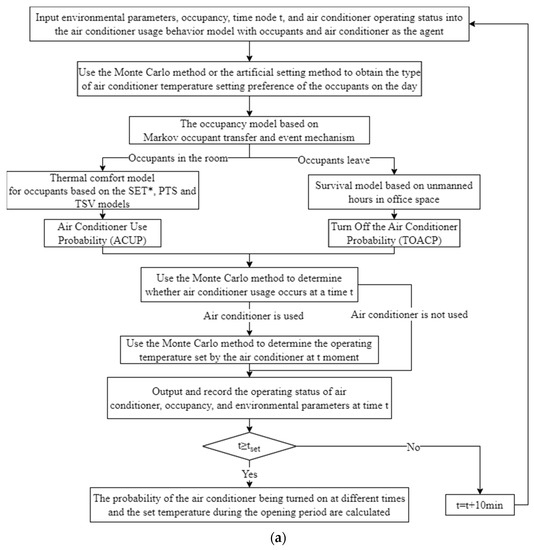
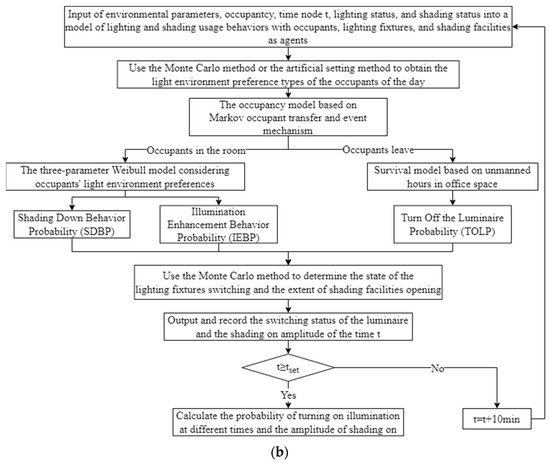
Figure 1.
(a) The modeling process and internal operation rules of agent-based air conditioner usage behaviors (SET*, the standard effective temperature is an equivalent temperature index that assumes that people in the actual environment have the same mean skin temperature and skin wetness as those in an imaginary standard environment), (b) the modeling process and internal operation rules of agent-based lighting fixtures and shading facilities usage behaviors.
The questionnaire method is usually used to obtain the adjustment willingness of the occupants to the ambient temperature and Bayesian conditional probability under different thermal comfort conditions, and then the air conditioner use probability () under different environmental conditions can be obtained.
Combined with the clustering results of occupants’ preferences for air conditioner temperature settings, the probability of air conditioners operating at a certain temperature ) under different conditions can be achieved, which is expressed by Equation (6).
where is the air conditioner operation probability at a certain temperature and is the air conditioner use probability under the current environment and occupant conditions.
Survival analysis can be used to describe the probability that a certain time in the existence of an individual or group occurs over a period of time (defined as survival time). Survival models provide a better relationship between event occurrence and time period than other methods. The air conditioner is turned on during work time and will be kept on for a long time until the occupants leave the building at the end of the day. In most cases, the probability of an air conditioner being turned off during office hours is related to the length of time that occupants are away from the office. Typically, the longer the absent time is, the higher the shutdown probability will be, which is consistent with logistic distribution. The survival model thus provides a good description of the probability change of the air conditioner operation status. Log-logistic is a type of parametric survival model, which assumes that survival times follow a known logistic distribution.
The log-logistic model is established to describe the change in air conditioner shutdown probability due to the increase in occupants’ leaving time, and its survival function is shown as Equation (7).
where is the shape parameter; is the scale parameter; is the duration, min; and is the survival probability. Therefore, the probability distribution is shown as Equation (8).
where is the air conditioner shutdown probability; is the occupants’ leaving time, min; and and are the parameters.
The use of luminaries and shading facilities interact with each other and together affect the energy consumption of lighting in buildings. The Weibull three-parameter distribution takes the physiological and psychological factors of occupants into account, which is a more reasonable action probability description method suitable for small samples and has good adaptability to experimental data. Thus, this study adopts the Weibull distribution to describe occupants’ usage behaviors with illumination and shading.
When the light environment is insufficient, the lighting fixtures may be turned on or the shading facilities may be pulled up to introduce natural light. Therefore, the behaviors of turning on the luminaries and pulling up the shading facilities to enhance the work surface illumination are collectively referred to as illumination enhancement behavior, and the illumination enhancement behavior probability () can be expressed by Equation (9).
When the work surface illumination exceeds the occupants’ minimum comfortable illumination, the shading facilities may be pulled down. The shading down behavior probability () can be calculated by Equation (10).
where is the work surface illumination, ; and are, respectively, the occupants’ maximum and minimum work surface comfortable illumination, ; is the shape parameter, reflecting the sensitivity of behaviors to environmental changes; and is the scale parameter, reflecting the scale factor for environmental stimuli. Let and the dimension of is the same as that of . is the dimensionless of environment variables .
As with air conditioner usage behavior, lighting off behavior also follows the survival model.
- (3)
- Usage behaviors of environment-independent equipment.
Due to the similarity of socket-related equipment usage behaviors, the usage behaviors for sockets are thus simplified to the usage behaviors for computers in this study. The computer usage behaviors can be divided into switching behavior and power adjustment behavior. The power adjustment behavior means that the computer operation power is adjusted to different levels for different occupants’ use demand. The socket operation power levels at off state and full load are set to 0 and 1, respectively. For the sockets under low load and medium load state, the power levels are determined by the ratio of their power to full load, respectively. To describe the socket usage behaviors, occupants and sockets are set as different agents to explore the interaction between them in this study. The modeling process and internal operation rules of agent-based socket usage behaviors are shown in Figure 2.
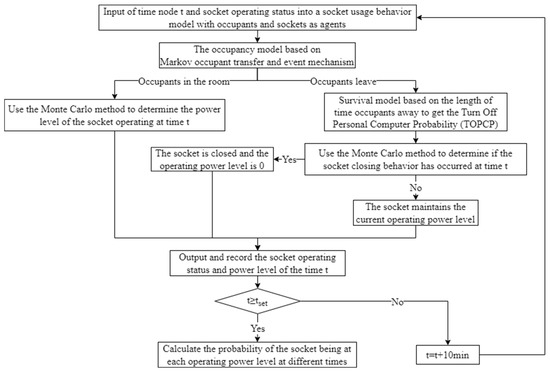
Figure 2.
The modeling process and internal operation rules of agent-based socket usage behaviors.
The multivariate normal distribution is a generalization of the univariate normal distribution and is usually used to solve situations where data under the same set contains multiple distributions. According to the occupant behavior and power consumption characteristics of typical household appliances [38], it reveals that there is an obvious correlation between the pattern of water intake and commuting pattern of people in the building, showing the characteristics of multi-peaked distribution, which is suitable for the description by using the combination of multiple normal distributions. At the same time, the expression of multivariate normal distribution is easy to handle, and the results of the theoretical derivation are concise. Therefore, multivariate normal distribution is used when considering the variation pattern of the number of occupants taking water from drinking dispensers over time.
The pattern of variation in the number of occupants taking water from the water dispenser over time can be described by the combination of multiple normal distributions, which is shown in Equation (11).
where is the number of occupants going to the water dispenser during t period, and , and are fitting parameters of normal distribution.
3. Case Study
3.1. Case Study
In this study, eight different types of office buildings in Tianjin, China, were selected and investigated for their function, building area, and basic energy consumption. The eight buildings included two research office buildings, two general office buildings, two community office buildings, and two commercial office buildings. Among those, the two commercial office buildings were selected as case buildings for detailed validation of the proposed prediction method, namely Case Building A and Case Building B, due to their suitable size and complete monitoring equipment.
Case Building A is an office building with a total gross building area of 18,088.09 square meters, as shown in Figure 3a. The interior of the building is used for office space of approximately 8000 square meters, with a total of 110 office spaces and ancillary rooms, including 59 single-occupancy offices, 35 multi-occupancy offices, and 16 conference rooms. The air conditioning system in the building is controlled by an intelligent control system. The building’s operating hours are from 8:30 to 17:30. The building is equipped with a full set of IoT energy monitoring platforms, which enables real-time monitoring and recording of the energy consumption and equipment operation status in the building.
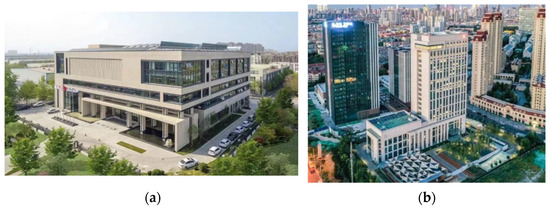
Figure 3.
(a) Exterior of Case Building A, (b) exterior of Case Building B.
Case Building B is an office building with 20 floors above ground and two underground floors, as shown in Figure 3b. The total building area is approximately 36,000 square meters. The first to third floors of the building are exhibition halls with centralized air conditioning systems. The fourth to 19th floors are mostly office spaces and their ancillary rooms, with VRV fan coils and fresh air systems. The cooling area of the VRV system is approximately 15,500 square meters with 139 office spaces and ancillary rooms of different sizes and forms, including 40 single-occupancy offices, 69 multi-occupancy offices, and 30 ancillary rooms, such as conference rooms. The building was officially opened in 2021 and a building energy monitoring platform was installed at the beginning of the cooling season in 2021.
3.2. Data Access
This study uses both physical monitoring and questionnaires for data collection. Monitoring platforms and devices such as infrared counters, temperature and humidity sensors, smart sockets, light sensors, door and window sensors, and cameras arranged in the case buildings are used to carry out long-term physical monitoring for environmental parameters data, energy consumption data, and occupant actions. Based on the monitoring data, a comprehensive survey of the basic information, behavioral habits, movement triggers, and environmental preferences of the building occupants is carried out by questionnaires to evaluate the environmental conditions and the preferences of different types of occupants.
3.2.1. Physical Testing
Both the outdoor and indoor environment were tested for the case buildings. The acquisition of hourly outdoor meteorological parameters was monitored by a weather station installed on top of the building during the study period, including solar radiation intensity, outdoor illuminance, outdoor dry and wet bulb temperature, and wind speed. The acquisition of indoor environmental parameters, including indoor temperature, relative humidity, and indoor working surface illuminance, was achieved by installed data loggers in the room. The corresponding data loggers and recording steps selected for this study are shown in Figure 4 and Table 1.
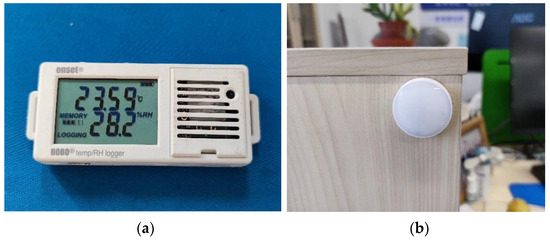
Figure 4.
(a) HOBO temperature and humidity sensors, (b) Mijia light sensors.

Table 1.
Indoor test parameters and instruments.
The monitoring of occupant actions was implemented by both the monitoring of occupant movements and equipment usage behaviors. For occupant movements, the infrared counter for occupancy, which can be easily installed at the entrance and exit of the tested area, was used to record the number of occupants entering and leaving the office space, as shown in Figure 5. For the monitoring of occupant’s switching on and off of lights, cameras were placed in the office space as shown in Figure 6. The window and door sensors were used to record the frequency and duration of window opening and closing, as shown in Figure 7a. The smart socket was selected to monitor and record the power of the socket, as shown in Figure 7b. As for the usage pattern of the water dispensers, in addition to adding smart sockets to the sockets of the water dispensers, infrared counters were also installed at the entrances and exits of the water room to monitor the number of occupants taking water. The selection of monitoring instruments and the relevant parameters are shown in Table 2.

Figure 5.
Infrared counters (pair).
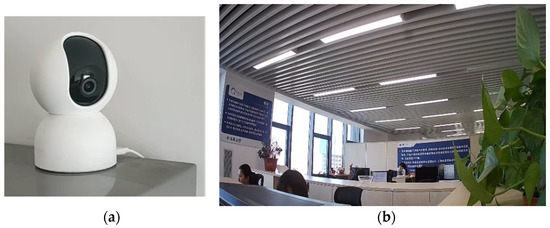
Figure 6.
(a) Smart cameras, (b) camera screen.
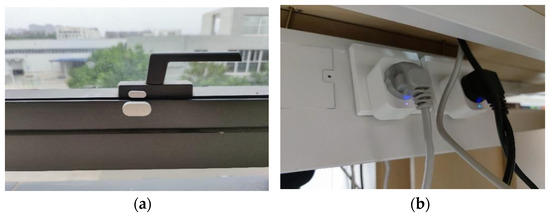
Figure 7.
(a) Door and window sensors, (b) smart sockets.

Table 2.
Monitoring instruments of occupant actions.
Based on the energy consumption monitoring platforms of case buildings A and B, the building energy consumption data of the two buildings for the cooling season in 2021 was also obtained, as shown in Table 3.

Table 3.
Available energy data from monitoring platform.
3.2.2. Questionnaires
The questionnaire included five aspects: firstly, basic information about the occupants, such as age, gender, and clothing characteristics; secondly, assessment of the thermal environment and air conditioner preferences; thirdly, assessment of the light environment and adjustment preferences to lighting fixtures and shading facilities; fourthly, preferences for the use of other energy-using equipment; and fifthly, the awareness of energy saving. Approximately 220 occupants within the case buildings were invited to fill in the questionnaire and 160 questionnaires were sent, with a coverage rate of 72.7%. A total of 153 valid questionnaires were returned, with an effective rate of 95.6%. There were 78 male participants and 75 female participants, a close ratio of men to women, meeting the needs of the study.
4. Building Energy Consumption Prediction Models
4.1. Decomposition and Description of Building Energy Consumption Based on Wavelet Transform
4.1.1. Low Frequency Signals
The general situation of the eight sample office buildings is similar, so the same method can be used for energy consumption decomposition and analysis for any one of them. Here, Case Building B is taken as an example for description. A wavelet transform and reconstruction program written in MATLAB R2018a was used to decompose and reconstruct the hourly energy consumption data of Case Building B during the air conditioning season. The reconstructed low-frequency signals of orders 1–5 were extracted from them, and Pearson correlation coefficients were used to describe the correlation between the low-frequency signals of each order and the original signals. Figure 8 and Table 4 show the comparison between the reconstructed low-frequency signals of orders 1–5 and the average of the measured data.
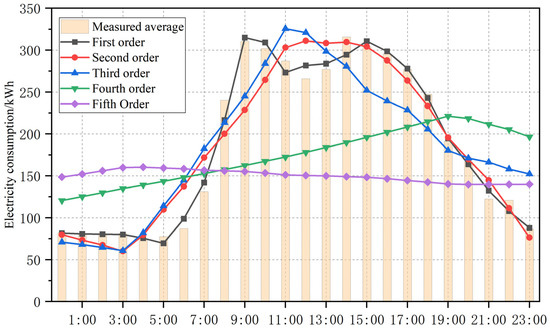
Figure 8.
Comparison of wavelet transformed and reconstructed low-frequency signals with the original signals.

Table 4.
Correlation between low-frequency reconstructed signals of various orders and measured data.
From Figure 8 and Table 4, it can be seen that the correlation between the first, second, and third order signals and the original signals are all relatively significant. As the Pearson correlation coefficient between the first-order low-frequency reconstruction signal and the measured data is the largest, the first-order low-frequency signal with the strongest correlation with the original data signal is chosen to reflect the original building energy consumption.
4.1.2. High-Frequency Signals
Define as the difference between ACUP or IEBP at the current moment and ACUP or IEBP at the previous moment, i.e., . If , the occupant is considered to turn on the air conditioning or lighting at the current moment, and the air conditioning or lighting behavior at the current moment is defined as 1. If , the air conditioning or lighting is assumed to be turned off at the current moment, and the air conditioning or lighting behavior at the current moment is defined as −1. If , the occupant is considered to have no actions on the air conditioning or lighting system, and the air conditioning or lighting behavior at the current moment is defined as 0. In this way, the uncertain occupant behaviors can be quantified as hourly numerical step signals. Figure 9 illustrates the relationship between the first- to the fifth-order high-frequency signals and the numerical step signals. The Pearson correlation coefficients between the equipment usage behavioral step signals and the reconstructed high-frequency signals are shown in Table 5.
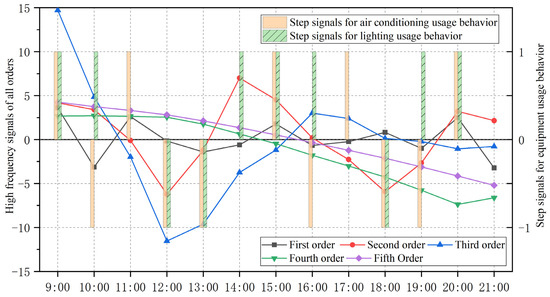
Figure 9.
Decomposed and reconstructed high-frequency signals and numerical step signals.

Table 5.
Correlation between each order of high-frequency signals and the numerical step signals.
From Figure 9 and Table 5, it can be seen that the air conditioning usage behavior has the greatest correlation with the first-order high-frequency signal, while the illumination usage behavior has the greatest correlation with the second-order high-frequency signal. It reveals that the high-frequency signal can reflect uncertainty in equipment usage behavior of the building occupants to a certain extent.
4.2. The Occupants’ Energy-Using Behavior Description Based on Agent-Based Model
4.2.1. Usage Behavior Description of Environment-Related Equipment
- (1)
- Air conditioner usage behavior
Air conditioning temperature settings are directly related to occupants’ preferences for the thermal environment. To further clarify the differences in occupants’ environmental preferences, the k-means clustering method was used to categorize occupants’ preferences for air conditioning temperature settings according to the questionnaire results, which can be divided into three preference types: low temperature, medium temperature, and high temperature.
In this study, the second-order Gaussian model is adopted to describe the cumulative probability of different occupants’ presence in the building, which can be expressed by Equation (12).
The presence probability of the occupants with certain air conditioning temperature setting preferences is shown in Equation (13).
When the occupant’s air conditioning temperature setting preference type is known, the relative presence probability of different air conditioning temperature settings in this type can be obtained as shown in Table 6.

Table 6.
Relative probability of the occurrence of different air conditioning temperature setting preferences.
When calculating the index standard effective temperature (), the standard person is considered uniformly for both genders. The change rules of the standard occupant’s value with the ambient temperature can be obtained as shown in Equation (14).
The corresponding relationship between , thermal sensation voting (TSV), and thermal comfort voting (TCV) can be obtained by verifying the thermal sensation corresponding to the value range of . When the ambient temperature exceeds the occupants’ comfortable temperature range, the probability of the air conditioner being used increases rapidly.
If the occupant decides to leave the office for a period of time during the working period, the decision whether to turn off the air conditioner is based on the duration of departure, which is independent of the ambient temperature conditions. To more clearly describe the change rules of the TOACP with the duration of departure during the working period, the regression fitting result is obtained from the questionnaires, as shown in Figure 10.
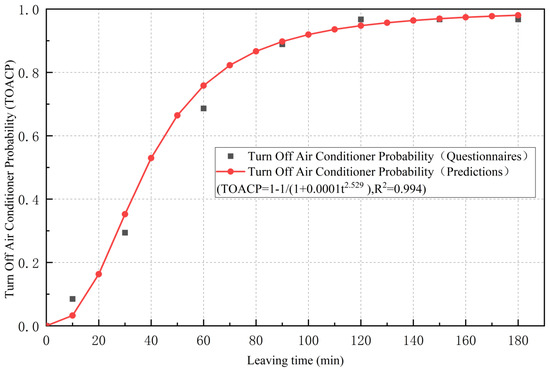
Figure 10.
Variation in the TOACP with the length of time the occupant is absent.
As seen in Figure 10, the TOACP increases rapidly as the duration of departure increases, and when the occupants leave the office for more than 90 min or after work, the air conditioning will definitely be turned off.
- (2)
- Illumination and shading usage behaviors.
According to the test results of the occupants’ acceptable illuminance threshold and comfortable illuminance interval, the occupants’ illuminance preferences can be divided into three preference types: bright environment, moderate environment, and dark environment. Each preference type for work surface illumination is classified by the k-means clustering method. According to the questionnaire analysis, the occupant presence probability of the dark environment, moderate environment, and bright environment preference type is 32%, 17%, and 51%, respectively.
To describe lighting behavior characteristics, the factors that affect the lighting on/off behaviors need to be understood first. According to the questionnaires and test results, the main factors influencing occupants’ lighting behaviors are the occupancy rate, work surface illumination, and duration of departure. When the occupants are present in the room, work surface illumination is the main factor affecting the occupants’ lighting behaviors. Work surface illuminance is recorded at the moment before the lights are turned on, and the work surface illuminance range is 44~506 lux. Therefore, when the work surface illumination level is higher than 506 lux, no artificial lighting is needed, regardless of whether the occupants are in the room or not. However, when the occupants are in the room, as long as the work surface illumination is lower than 44 lux, the lights should be turned on to improve the indoor illumination level.
The time-by-time TOLP in two multi-occupancy offices and one single-occupancy office on working days is statistically analyzed, as shown in Figure 11.
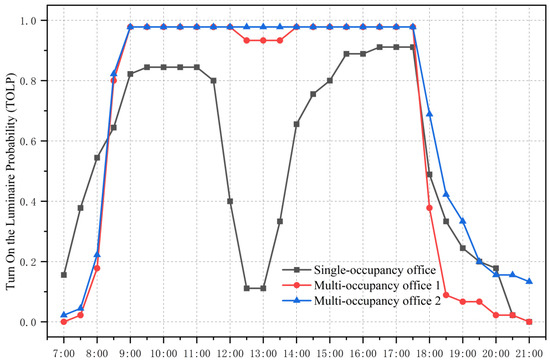
Figure 11.
Turn on the luminaire probability in offices.
As can be seen from Figure 11, the turn-on rules of lighting are in accordance with the building operation schedule and the occupant’s work schedule. Once the lights are turned on in multi-occupancy offices, they will be kept on for a long time during the working period until the last occupant leaves. Compared with multi-occupancy offices, the lighting turned-on probability in the single-occupancy office during working hours is lower, and the lighting turned-off probability is higher when the occupants leave the office. Therefore, the influence of the departure duration is particularly evident on the lighting turned-off behavior.
The behaviors of turning on the lights and pulling up the shade to improve work surface illuminance are defined as illumination enhancement behaviors. The probability of illumination enhancement behaviors of three occupant types under different environmental conditions is fitted separately in SPSS, which is shown in Figure 12 and Table 7.

Figure 12.
Probability of illumination enhancement behavior of different occupant types.

Table 7.
Probability fitting equation for illumination enhancement behavior of different occupant types.
With the increase in work surface illumination, the probability of illumination enhancement behavior shows a downward trend. When the illumination reaches the occupant’s comfort zone, the probability of illumination enhancement behavior decreases rapidly. However, when the illuminance exceeds the occupant’s comfort zone, the behavior of increasing the illuminance will hardly occur.
However, when work surface illumination is too high, shading behavior may occur to reduce illumination. Under different work surface illumination conditions, Weibull three-parameter fitting was performed for the probability of shading, as shown in Figure 13 and Table 8.
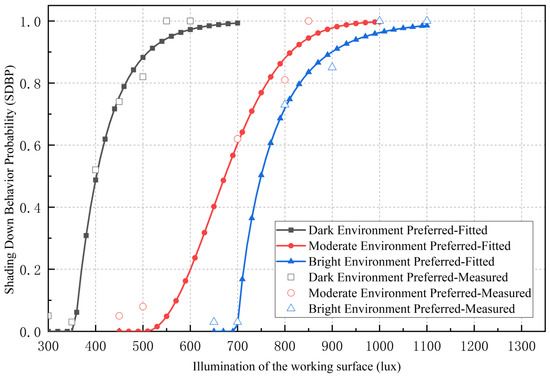
Figure 13.
Surface illumination conditions.

Table 8.
Probability fitting equation for the shading behavior of different occupant types.
To more clearly describe the TOLP during the working time period according to occupants’ departure, the data obtained from the questionnaires were fitted with a survival model for regression, which is shown in Figure 14.
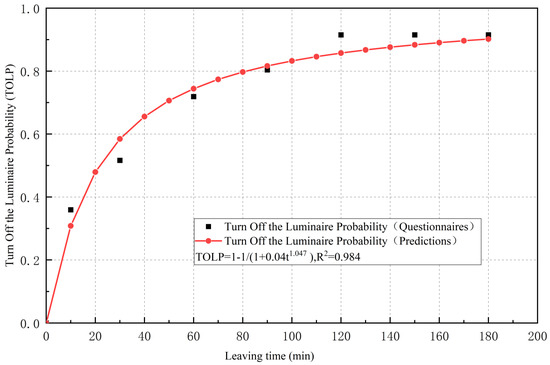
Figure 14.
Probability of the lights being turned off with the departure duration.
In Figure 14, the TOLP rises with the increase in departure duration, with a maximum value of approximately 0.92. That is because some occupants prefer not to turn off the lights even when they leave the office for a long time.
4.2.2. Usage Behavior Description of Environment-Independent Equipment
- (1)
- Socket usage behaviors.
The hourly power levels during the working period (8:30–11:30 and 13:30–17:30) can be divided into three levels by the k-means clustering method. The probability of low-power, medium-power, and high-power levels in the computer operation state are 0.20, 0.51, and 0.29, respectively. The computer power in the low power and normal operation state is, respectively, approximately 20% and 69% of the full load power. The shutdown probability of the computer according to the departure duration is shown in Figure 15.

Figure 15.
Shutdown probability according to the departure duration.
It can be seen from Figure 15 that the shutdown probability of the computer increases with the increase in the departure duration. The maximum value is 0.89. Some occupants prefer not to shut down the computer when they leave the office.
- (2)
- Water dispenser usage behaviors.
The energy-using behaviors of the water dispenser are jointly determined by the heating mode settings and occupants’ water-using habits. Through monitoring the number of occupants taking water from a water dispenser in the building, an obvious correlation between the rules of occupants taking water and commuting was discovered. The Gaussian mixture model was adopted for fitting, which can better describe the change characteristics of the number of occupants taking water over time, as shown in Equation (15).
Based on the description of occupants’ water-using behavior characteristics, the number of occupants taking water from a water dispenser presents a bimodal distribution with time. The number of occupants taking water from the water dispenser obtained by fitting the measured data of specific buildings cannot be applied to other office buildings with different movement characteristics. Therefore, the fitted Gaussian mixture model, which reflects the typical characteristics of the number of occupants taking water over time, can be deemed as the sum of two normal distribution functions. The bi-normal model is shown in Figure 16.
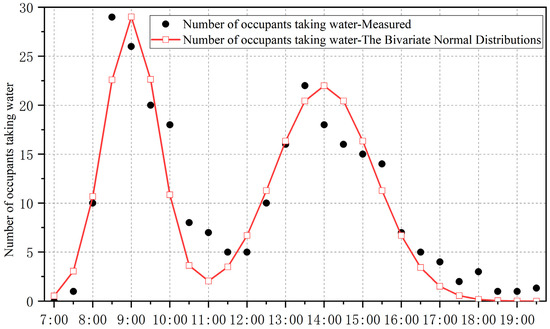
Figure 16.
The bi-normal model.
It can be seen from Figure 16 that the bi-normal model is basically consistent with the measured values in case buildings. As for the water dispenser, its lowest point in the morning occurs at the earliest moment when occupants arrive at the building, the lowest point in the afternoon occurs at the latest moment when occupants leave, and the highest point occurs at the moment after work. The Pearson correlation coefficient between the fitting values of the bi-normal distribution and the measured values is 0.940, and the obvious correlation between the two is proven. Therefore, the double normal distribution model can be used to describe the variation of the number of occupants taking water in different buildings over time.
5. Prediction Results and Discussion
5.1. Prediction Results of Equipment Usage Behaviors
5.1.1. Prediction Results in Occupant View
- (1)
- Impacts of office occupancy on air conditioning and illumination.
Based on the results of testing and monitoring, the opening probability and the average daily use of air conditioning and illumination in multi-occupancy offices are significantly higher than those in single-occupancy offices during working hours. To clarify the effects of office occupancy on equipment usage behaviors, a movement model based on the Markov method and an event mechanism with occupants, equipment, and environment as agents were developed in AnyLogic. By keeping the occupant movement model and equipment usage behavior constant, a simulation was implemented with varied occupancy. Figure 17 illustrates the influence of office occupancy rates on the average daily running hours of air conditioning and illumination.
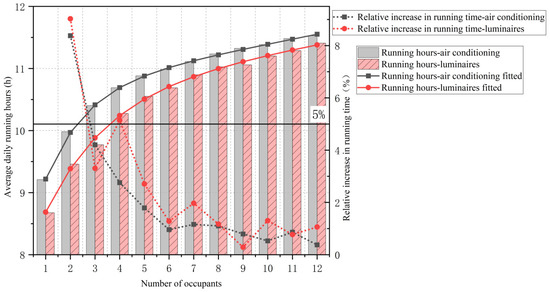
Figure 17.
Influence of the number of office occupants on the average daily running time of equipment.
As can be seen from Figure 17, the expected daily running time of air conditioning and illumination in the office show a typical exponential function distribution with the increase in office occupancy, as shown in Table 9.

Table 9.
Patterns of average daily running hours of air conditioning and illumination with the occupant number.
The presence of multiple occupants in the room will lead to a higher ACUP and IEBP, both of which contribute to the increase in the average daily running hours of air conditioning and illumination in the office with the increase in occupancy.
- (2)
- Influence of occupant awareness of energy saving on equipment usage behaviors.
The impact of energy-saving awareness on air conditioning, illumination, and PC usage behaviors is exerted through the length of time the office is unoccupied, which is influenced by a combination of the number of occupants in the office, the probability of occupants leaving, and the departure duration. To investigate the influence of occupant awareness on equipment usage behaviors, a scenario approach was used to assume that the dominant occupants in the office have poor, fair, strong, and average levels of energy-saving awareness, while the occupants in single-occupancy offices were used as the reference. A poor energy-aware person means that the person will not turn off the equipment no matter how long he leaves the office; a fair energy-aware person means that the person has a 50% probability of turning off the equipment when he leaves the office; a strong energy-aware person means that the person will definitely choose to turn off the equipment when he leaves the office; and an average energy-aware person means that the person’s probability of turning off the equipment fits a survival model that varies with the length of time he is absent. As the occupants cannot determine the departure duration from their office, the duration of their last departure for the same type of activity was used in the survival model.
The probability of occupant departure in the morning and afternoon is assumed to conform to a uniform distribution on a scale of zero to one, and the duration of departure is assumed to conform to a uniform distribution on a scale of 10 to 120 min. Figure 18 shows the average ACUP and IEBP during a typical period of time in an office with different occupancy levels and awareness of energy saving under the set scenarios.
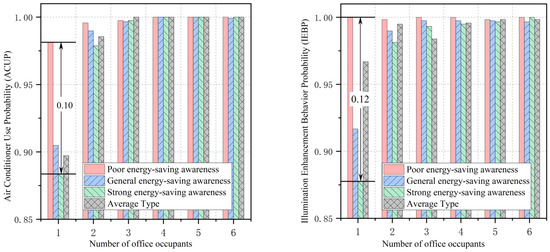
Figure 18.
The average ACUP and IEBP during a typical period of time in an office with different occupancy levels and awareness of energy saving.
As can be seen from Figure 18, the impact of occupant awareness on ACUP and IEBP decreases rapidly as the number of occupants increases, showing that ACUP and IEBP in offices dominated by occupants with different levels of energy-saving awareness tend to be equal at typical times. The reason for this is that as the occupancy increases, the probability that occupants will turn off the equipment based on their own energy-saving awareness decreases. When the number of occupants in an office is three or more, the influence of the awareness of the occupants on the usage behavior of air conditioning and illumination can be ignored.
5.1.2. Prediction Results in Building View
- (1)
- Influence of the office type on the usage behaviors of air conditioning and illumination.
Common types of office space include single-occupancy offices, multi-occupancy offices, and conference rooms. Figure 19 shows the comparison between the average daily running hours of air conditioning and illumination for different types of office space.
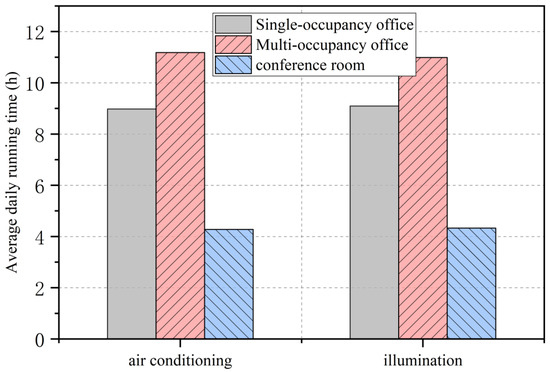
Figure 19.
Effects of the type of office space on the running hours of air conditioning.
As can be seen in Figure 19, even when following the same rules of movement and behavior, there are still significant differences in the average daily running hours of air conditioning and illumination for the different types of office spaces in office buildings, particularly in conference rooms, where the average daily running hours of air conditioning and illumination are more than 50% lower than offices.
The large differences in the usage behaviors of illumination and shading in the different types of office spaces may be explained by the lower average ACUP and IEBP during working hours in conference rooms. Figure 20 shows a comparison of ACUP in different types of office space during working hours under set scenarios.
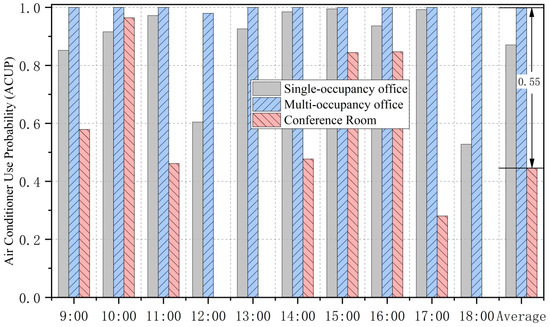
Figure 20.
Comparison of ACUP in different types of office space and the variations over time.
As can be seen in Figure 20, ACUP in the office is higher than in the conference room at different times of the day, with the difference between the two being approximately 55% on average during working hours. Although ACUP in the conference room is much higher in the middle of the morning and afternoon than during the rest of the day, the conference room is only used for part of the day, and the air conditioning is often turned off when occupants leave. That is the reason why the average ACUP in the conference room and the average daily running hours are lower than in the offices.
5.2. Results of Energy Consumption Predictions
5.2.1. Results of the Basic Energy Prediction
Figure 21 shows the basic energy consumption of the eight office buildings obtained from the research in relation to the building area.
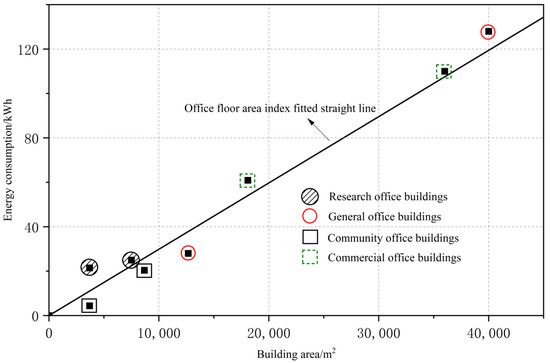
Figure 21.
Correspondence between building area and base energy consumption for different types of office buildings.
As can be seen from Figure 10, there are huge differences in the basic energy consumption of different types of office buildings, probably due to different office intensities, different staff densities, and different power-consuming equipment. Fitting by SPSS, the corresponding relationship between the basic energy consumption and building area show an approximate linear correlation. The area-based index relationship of the eight office buildings applicable to this study is shown in Equation (16).
where is the hourly base energy consumption of an ordinary office building, kWh; and A is the area of the office building, m2.
Based on the fitted formulae for basic energy consumption and the building area, the prediction results of Case Buildings A and B are shown in Figure 22.
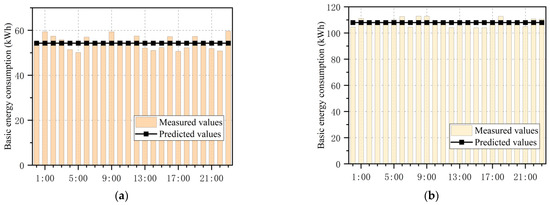
Figure 22.
(a) Comparison of the predicted and measured results of the basic energy consumption of Case Building A, (b) comparison of the predicted and measured results of the basic energy consumption of Case Building B.
As can be seen in Figure 22, the maximum deviation between the prediction results and monitoring records is no more than 8%, indicating that the prediction model of office building basic energy consumption based on area indicators can effectively achieve the prediction of office building basic energy consumption.
5.2.2. Results of the Variable Energy Prediction
The prediction of variable energy consumption in the case buildings can be achieved by inputting the characteristics of occupant presence in the buildings, the proportion of different types of office space in the buildings, and the rated power of energy-using equipment into the ABM model. Figure 23 shows the comparison between the building variable energy consumption simulated with the ABM model and the measured value.

Figure 23.
(a) Comparison of simulated and measured values of variable energy consumption in Case Building A, (b) comparison of simulated and measured values of variable energy consumption in Case Building B.
As can be seen from Figure 23, the variable energy consumption of the case buildings simulated by the variable energy prediction model for office buildings based on the agent-based model is relatively close to the variable energy consumption obtained from the actual measurements. Among them, the Pearson correlation coefficient in Figure 23a is 0.991, and the total deviation between the simulated and measured values is within 1.9%; the Pearson correlation coefficient in Figure 23b is 0.994, and the deviation is within 5.3%, which proves that there is an obvious correlation between the two. It shows that the agent-based variable energy consumption prediction model for office buildings can reflect the change pattern of variable energy consumption in office buildings over time, and achieve the prediction of variable energy consumption in case buildings.
It should also be noted that there are time periods in the figures where the difference between the simulated and measured values is large. This may be due to the fact that the behavioral patterns of occupants obtained from this study are limited to predict the equipment usage behaviors in specific buildings.
5.2.3. Results of Total Energy Consumption Predictions
In summary, the two-part model accurately predicted the total energy consumption of Case Buildings A and B, as shown in Figure 24.
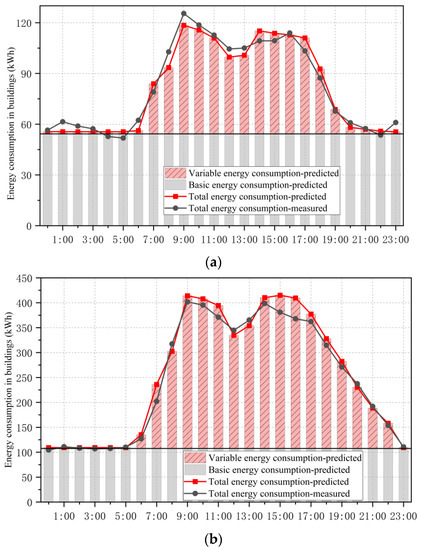
Figure 24.
(a) Comparison of measured and predicted total energy consumption in Case Building A, (b) comparison of measured and predicted total energy consumption in Case Building B.
As can be seen from the Figure 24, the average deviations between the predicted total energy consumption and the measured values are approximately 1% and 2.8%, and the maximum deviations of hourly energy consumption are approximately 7.4% and 10.1%, respectively, for Building A and Building B during the working time period. The Pearson correlation coefficients between the predicted hourly energy consumption and the measured values are 0.984 and 0.994, respectively, for the two case buildings.
To validate the advanced nature of the proposed method for predicting energy consumption in office buildings based on agents, the following five scenarios were set out for further investigation of the influences of occupant behaviors, occupant interactions, and office space types on the energy consumption prediction of office buildings, as shown in Table 10.

Table 10.
Considerations for scenario setting.
The behavior of occupants, i.e., the building operates according to the standard recommended schedule, was not considered in Scenario 1. Only equipment usage behavior was considered in Scenario 2, i.e., the building was considered to be made up of office rooms only. Both the interactions between occupants and their interactions with office equipment, i.e., the building was considered to consist of an equal proportion of single and multi-occupancy offices. The behavior of occupants and office space types were considered in Scenario 4 without considering occupant interaction, i.e., the building was considered to consist of multi-occupancy offices and conference rooms. Scenario 5 combines the probability of occupant behavior, occupant interaction, and different space types occurring in the building, i.e., the agent-based variable energy prediction model for office buildings proposed in this study. Figure 25 and Table 11 show the simulated variable energy consumption of the office buildings compared to the measured variable energy consumption under those five scenarios.
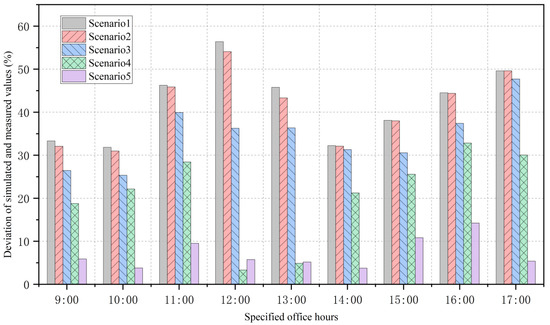
Figure 25.
Deviations between simulated and measured variable energy consumption under different scenarios.

Table 11.
Comparison of variable energy consumption prediction effects under different scenarios.
The results show that considering the effect of occupant usage behavior on equipment in the prediction of energy consumption in office buildings can improve the accuracy of energy consumption prediction by approximately 1.3%. Taking the effect of occupant behavior and occupant interaction into account also improves the prediction accuracy by approximately 21.4%. Considering the effect of all three factors at the same time improves the prediction accuracy by approximately 55.8%.
6. Conclusions
This study divides the total energy consumption of office buildings into a basic energy consumption part related to building area and a variable energy consumption part related to uncertain occupant behaviors. The proposed method for predicting energy consumption in office buildings based on ABM takes the occupant–equipment interaction and the occurrence probability of different occupant types into account, enabling a more accurate and reasonable prediction of building energy consumption. The main conclusions of this research are as follows.
(1) An examination of the influencing factors of equipment usage behaviors reveals that the number of office occupants and the type of office space have a significant impact on equipment usage behaviors of occupants at the building level, while the probability of different environmental preferences being present in the building has a significant impact on equipment usage behaviors at the occupant level. To achieve accurate predictions of variable energy consumption in buildings, it is necessary to consider not only the proportion of different space types in the building, but also the probability of different types of occupants being present in the building.
(2) The increase in occupancy leads to an increase in the average daily running hours of air conditioning and illumination in the office space, mainly due to the earlier turn-on time and the later turn-off time. However, when this office space is occupied by more occupants, such impact is no longer significant. The office space type affects air conditioning and illumination usage behaviors, with the average daily running hours of air conditioning and illumination in conference rooms varying by more than 50% compared to offices. The influence of occupant energy saving awareness on air conditioning and illumination usage behaviors is more significant in the case of single-occupant offices, while the influence is limited once more by occupants appearing in the office. Occupant environmental preferences can significantly influence air conditioning and illumination usage behaviors, as evidenced by different air conditioning setting temperatures and different average daily running hours of illumination.
(3) For basic energy consumption, the maximum error between the prediction results and monitoring records is no more than 8% by the prediction model based on area indicators. For variable energy consumption, simulated based on the agent-based model, the total error in Case Building A between the simulated and measured values is within 1.9%, whereas that of Case Building B is within 5.3%. The error between the predicted total energy consumption of office buildings by the proposed two-part model and the monitoring records is only 2.8%.
(4) Compared to the prediction method which does not consider occupant–equipment interactions, simultaneously considering the influencing effects of single-occupant behavior, multi-occupant behavior, and office space type can improve the accuracy of office energy consumption prediction by 55.8%.
This study takes occupant–equipment interactions that influence the energy consumption prediction for office buildings into account. The application of the prediction method mainly has three aspects: combining behavioral models that describe the occupancy and the interaction correlation between the occupants and the building systems with energy simulation to reflect the impact of occupant behavior on building energy efficiency, improving the accuracy of the load and energy consumption prediction model of office building simulation, and providing better energy-saving control strategies of HVAC and lighting systems. However, through the limited case validation, the building type has limited potential to prove the feasibility of the prediction model. In practice, the energy prediction method is assumed to be applicable to different types of buildings. The coefficients of the fitted curves need to be modified in the basic energy consumption part, whereas for the variable energy consumption part, the agent-based model can cover more specific equipment usage behaviors. In future studies, the proposed prediction model can be extended and validated in different geographic areas and various types of public buildings.
Author Contributions
Conceptualization, Y.D.; methodology, Y.D.; formal analysis, W.C.; investigation, Q.H.; resources, Z.W.; data curation, Z.W.; writing—original draft preparation, X.P.; writing—review and editing, Z.T. and Y.D.; visualization, W.C. All authors have read and agreed to the published version of the manuscript.
Funding
This research was funded by the Key R&D Program of Tianjin (20YFZCGX00950).
Acknowledgments
This work was financially supported by the Key R&D Program of Tianjin (20YFZCGX00950).
Conflicts of Interest
The authors declare no conflict of interest.
References
- Shi, L.; Zhang, G.K.; Yang, W.; Huang, D.; Cheng, X.; Setunge, S. Determining the influencing factors on the performance of solar chimney in buildings. Renew. Sustain. Energy Rev. 2018, 88, 223–238. [Google Scholar] [CrossRef]
- Xu, X.; Chen, C.-F.; Li, D.; Menassa, C. Energy Saving at Work: Exploring the Role of Social Norms, Perceived Control and Ascribed Responsibility in Different Office Layouts. Front. Built Environ. 2020, 6, 12. [Google Scholar] [CrossRef]
- Sun, Y.; Haghighat, F.; Fung, B.C.M. A review of the -state-of-the-art in data -driven approaches for building energy prediction. Energy Build. 2020, 221, 110022. [Google Scholar] [CrossRef]
- Chen, S.; Zhang, G.; Xia, X.; Chen, Y.; Setunge, S.; Shi, L. The impacts of occupant behavior on building energy consumption: A review. Sustain. Energy Technol. Assess. 2021, 45, 101212. [Google Scholar] [CrossRef]
- Gray, F.M.; Schmidt, M. A hybrid approach to thermal building modelling using a combination of Gaussian processes and grey-box models. Energy Build. 2018, 165, 56–63. [Google Scholar] [CrossRef]
- Jia, M.D.; Srinivasan, R.S.; Raheem, A.A. From occupancy to occupant behavior: An analytical survey of data acquisition technologies, modeling methodologies and simulation coupling mechanisms for building energy efficiency. Renew. Sustain. Energy Rev. 2017, 68, 525–540. [Google Scholar] [CrossRef]
- Jia, M.; Srinivasan, R.; Ries, R.J.; Bharathy, G.; Weyer, N. Investigating the Impact of Actual and Modeled Occupant Behavior Information Input to Building Performance Simulation. Buildings 2021, 11, 32. [Google Scholar] [CrossRef]
- Geronazzo, A.; Brager, G.; Manu, S. Making sense of building data: New analysis methods for understanding indoor climate. Build. Environ. 2018, 128, 260–271. [Google Scholar] [CrossRef]
- Peng, Y.; Rysanek, A.; Nagy, Z.; Schlüter, A. Using machine learning techniques for occupancy-prediction-based cooling control in office buildings. Appl. Energy 2018, 211, 1343–1358. [Google Scholar] [CrossRef]
- Ahmadi-Karvigh, S.; Ghahramani, A.; Becerik-Gerber, B.; Soibelman, L. Real-time activity recognition for energy efficiency in buildings. Appl. Energy 2018, 211, 146–160. [Google Scholar] [CrossRef]
- Wang, S.; Kim, A.A.; Johnson, E.M. Understanding the deterministic and probabilistic business cases for occupant based plug load management strategies in commercial office buildings. Appl. Energy 2017, 191, 398–413. [Google Scholar] [CrossRef]
- Bertrand, A.; Mastrucci, A.; Schüler, N.; Aggoune, R.; Maréchal, F. Characterisation of domestic hot water end-uses for integrated urban thermal energy assessment and optimisation. Appl. Energy 2017, 186, 152–166. [Google Scholar] [CrossRef]
- Markovic, R.; Wolf, S.; Cao, J.; Spinnräker, E.; Wölki, D.; Frisch, J.; van Treeck, C. Comparison of Different Classification Algorithms for the Detection of User’s Interaction with Windows in Office Buildings. In Proceedings of the Cisbat 2017 International Conference Future Buildings & Districts—Energy Efficiency from Nano to Urban Scale, Lausanne, Switzerland, 6–8 September 2017; Volume 122, pp. 337–342. [Google Scholar]
- Pan, S.; Xiong, Y.; Han, Y.; Zhang, X.; Xia, L.; Wei, S.; Wu, J.; Han, M. A study on influential factors of occupant window-opening behavior in an office building in China. Build. Environ. 2018, 133, 41–50. [Google Scholar] [CrossRef]
- Baldi, S.; Korkas, C.D.; Lv, M.; Kosmatopoulos, E.B. Automating occupant-building interaction via smart zoning of thermostatic loads: A switched self-tuning approach. Appl. Energy 2018, 231, 1246–1258. [Google Scholar] [CrossRef]
- Menezes, A.C.; Cripps, A.; Bouchlaghem, D.; Buswell, R. Predicted vs. actual energy performance of non-domestic buildings: Using post-occupancy evaluation data to reduce the performance gap. Appl. Energy 2012, 97, 355–364. [Google Scholar] [CrossRef]
- Yun, G.Y.; Kim, H.; Kim, J.T. Effects of occupancy and lighting use patterns on lighting energy consumption. Energy Build. 2012, 46, 152–158. [Google Scholar] [CrossRef]
- Tuniki, H.P.; Jurelionis, A.; Fokaides, P. A review on the approaches in analysing energy-related occupant behaviour research. J. Build. Eng. 2021, 40, 102630. [Google Scholar] [CrossRef]
- Gassar, A.A.A.; Cha, S.H. Energy prediction techniques for large-scale buildings towards a sustainable built environment: A review. Energy Build. 2020, 224, 110238. [Google Scholar] [CrossRef]
- Cheng, Y.; Gao, M.; Dong, J.; Jia, J.; Zhao, X.; Li, G. Investigation on the daylight and overall energy performance of semi-transparent photovoltaic facades in cold climatic regions of China. Appl. Energy 2018, 232, 517–526. [Google Scholar] [CrossRef]
- Yao, J. Modelling and simulating occupant behaviour on air conditioning in residential buildings. Energy Build. 2018, 175, 1–10. [Google Scholar] [CrossRef]
- Fernández, M.; Zorita, A.; García-Escudero, L.; Duque, O.; Morinigo-Sotelo, D.; Riesco, M.; Muñoz, M. Cost optimization of electrical contracted capacity for large customers. Int. J. Electr. Power Energy Syst. 2013, 46, 123–131. [Google Scholar] [CrossRef]
- Zorita, A.L.; Fernández-Temprano, M.A.; García-Escudero, L.-A.; Duque-Perez, O. A statistical modeling approach to detect anomalies in energetic efficiency of buildings. Energy Build. 2016, 110, 377–386. [Google Scholar] [CrossRef]
- Ding, Y.; Ma, X.; Wei, S.; Chen, W. A prediction model coupling occupant lighting and shading behaviors in private offices. Energy Build. 2020, 216, 109939. [Google Scholar] [CrossRef]
- Pérez-Montalvo, E.; Zapata-Velásquez, M.-E.; Benítez-Vázquez, L.-M.; Cermeño-González, J.-M.; Alejandro-Miranda, J.; Martínez-Cabero, M.; de la Puente-Gil, Á. Model of monthly electricity consumption of healthcare buildings based on climatological variables using PCA and linear regression. Energy Rep. 2022, 8, 250–258. [Google Scholar] [CrossRef]
- Tom, R.J.; Sankaranarayanan, S.; Rodrigues, J.J.P.C. Agent negotiation in an IoT-Fog based power distribution system for demand reduction. Sustain. Energy Technol. Assess. 2020, 38, 100653. [Google Scholar] [CrossRef]
- Cao, J.J.; Choi, C.H.; Zhao, F. Agent-based modeling of the adoption of high-efficiency lighting in the residential sector. Sustain. Energy Technol. Assess. 2017, 19, 70–78. [Google Scholar] [CrossRef]
- Langevin, J.; Wen, J.; Gurian, P.L. Simulating the human-building interaction: Development and validation of an agent-based model of office occupant behaviors. Build. Environ. 2015, 88, 27–45. [Google Scholar] [CrossRef]
- Azar, E.; Menassa, C.C. Agent-Based Modeling of Occupants and Their Impact on Energy Use in Commercial Buildings. J. Comput. Civ. Eng. 2012, 26, 506–518. [Google Scholar] [CrossRef]
- Luo, X.; Lam, K.P.; Chen, Y.; Hong, T. Performance evaluation of an agent-based occupancy simulation model. Build. Environ. 2017, 115, 42–53. [Google Scholar] [CrossRef]
- Élie, R.; Hubert, E.; Mastrolia, T.; Possamaï, D. Mean-field moral hazard for optimal energy demand response management. Math. Financ. 2021, 31, 399–473. [Google Scholar] [CrossRef]
- Hurtado, L.A.; Nguyen, P.H.; Kling, W.L.; Zeiler, W. Building Energy Management Systems—Optimization of comfort and energy use. In Proceedings of the 2013 48th International Universities’ Power Engineering Conference (UPEC), Dublin, Ireland, 2–5 September 2013; pp. 1–6. [Google Scholar]
- Ghahramani, A.; Pantelic, J.; Lindberg, C.; Mehl, M.; Srinivasan, K.; Gilligan, B.; Arens, E. Learning occupants’ workplace interactions from wearable and stationary ambient sensing systems. Appl. Energy 2018, 230, 42–51. [Google Scholar] [CrossRef]
- Ding, Y.; Wang, Q.; Wang, Z.; Han, S.; Zhu, N. An occupancy-based model for building electricity consumption prediction: A case study of three campus buildings in Tianjin. Energy Build. 2019, 202, 109412. [Google Scholar] [CrossRef]
- Zhang, Y.; Li, C.; Li, L. Wavelet transform and Kernel-based extreme learning machine for electricity price forecasting. Energy Syst.-Optim. Model. Simul. Econ. Asp. 2018, 9, 113–134. [Google Scholar] [CrossRef]
- Tardioli, G.; Kerrigan, R.; Oates, M.; O’Donnell, J.; Finn, D.P. Identification of representative buildings and building groups in urban datasets using a novel pre-processing, classification, clustering and predictive modelling approach. Build. Environ. 2018, 140, 90–106. [Google Scholar] [CrossRef]
- de la Puente-Gila, Á.; González-Martínez, A.; Borge-Diez, D.; Martínez-Cabero, M.-Á.; deSimón-Martín, M. True power consumption labeling and mapping of the health system of the Castilla y Leon region in Spain by clustering techniques. Technol. Mater. Renew. Energy Environ. Sustain. (Tmrees) 2019, 157, 1164–1181. [Google Scholar] [CrossRef]
- Yan, D.; Jin, Y.; Sun, H.; Dong, B.; Ye, Z.; Li, Z.; Yuan, Y. Household appliance recognition through a Bayes classification model. Sustain. Cities Soc. 2019, 46, 101393. [Google Scholar] [CrossRef]
Publisher’s Note: MDPI stays neutral with regard to jurisdictional claims in published maps and institutional affiliations. |
© 2022 by the authors. Licensee MDPI, Basel, Switzerland. This article is an open access article distributed under the terms and conditions of the Creative Commons Attribution (CC BY) license (https://creativecommons.org/licenses/by/4.0/).